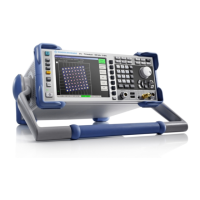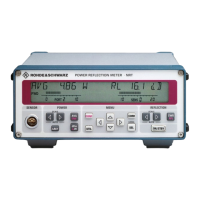R&S FSH Using the Markers
1309.6275.12 4.27 E-2
Using more than one marker at a time (multimarker mode)
T
o measure different signals in a trace, the R&S FSH has the multimarker function. Up to six different
markers are available. Marker 1 measures in absolute units. Markers 2 to 6 can measure in absolute
units (marker) as well as relative units (delta). The reference for delta markers is always marker 1.
Operating sequence:
Press the MARKER key.
Press the NEW MARKER softkey several times.
On each key-press a new marker will be created
and placed on the next lower signal peak.
The marker designation contains the number of the
marker in question (M1, D2, D3 etc.). The designation
of the marker which is active for editing (= active
marker) has a red background, whereas the other
markers have a grey background.
As a default new markers are created as delta
markers, which means that their position is displayed
relative to marker 1.
In order to transform a delta marker into a marker
press softkey MARKER TYPE. The marker
designation changes (e.g. D2 -> M2), and the
marker position is displayed in absolute values.
In order to select a previously created marker,
press softkey SELECT MARKER repeatedly until
the symbol of the desired marker is highlighted in
red.
The R&S FSH opens the entry box for the frequency of
the selected marker or the spacing between the delta
marker and the reference marker M1.
Using the cursor keys, place the marker or delta
marker near the position you want. The step width
here is 10 % of the X axis.
Then use the rotary knob to fine-tune the marker or
delta marker to the signal The step width
corresponds to the pixel spacing of the trace.
Alternatively, enter the desired position of the
marker or delta marker using the number keys and
terminate the entry with one of the unit keys.
The R&S FSH displays the last edited marker or Delta marker (= active marker) by means of a red
highlighted marker symbol. All marker functions relate to the active marker.

